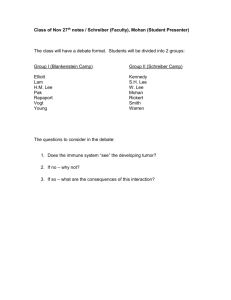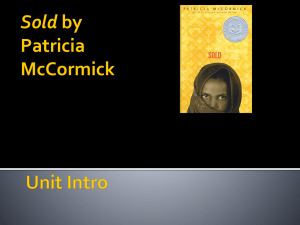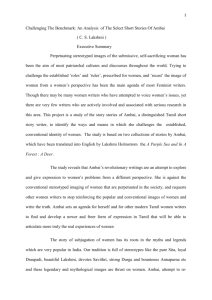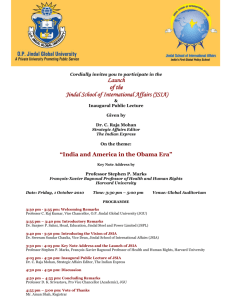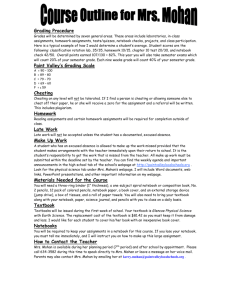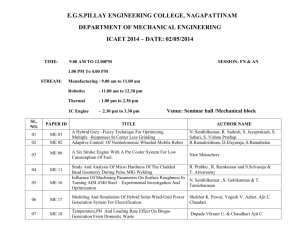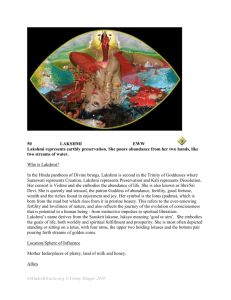Document
advertisement
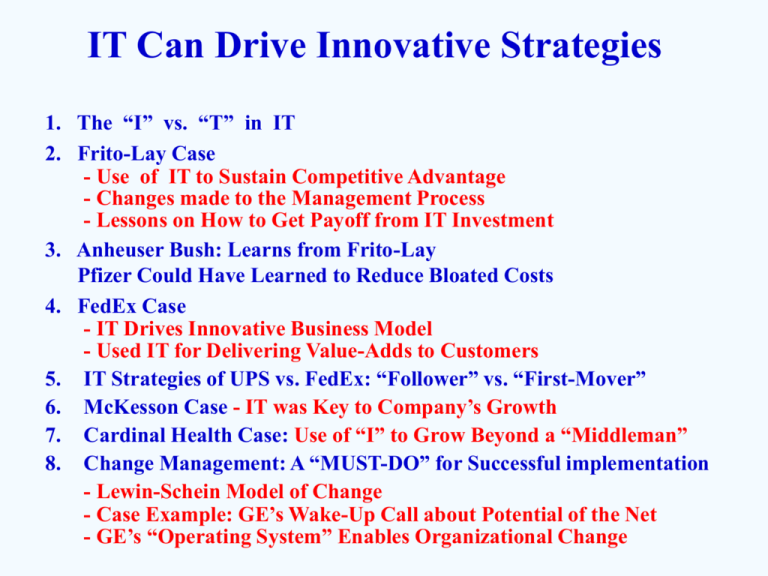
IT Can Drive Innovative Strategies 1. The “I” vs. “T” in IT 2. Frito-Lay Case - Use of IT to Sustain Competitive Advantage - Changes made to the Management Process - Lessons on How to Get Payoff from IT Investment 3. Anheuser Bush: Learns from Frito-Lay Pfizer Could Have Learned to Reduce Bloated Costs 4. FedEx Case - IT Drives Innovative Business Model - Used IT for Delivering Value-Adds to Customers 5. IT Strategies of UPS vs. FedEx: “Follower” vs. “First-Mover” 6. McKesson Case - IT was Key to Company’s Growth 7. Cardinal Health Case: Use of “I” to Grow Beyond a “Middleman” 8. Change Management: A “MUST-DO” for Successful implementation - Lewin-Schein Model of Change - Case Example: GE’s Wake-Up Call about Potential of the Net - GE’s “Operating System” Enables Organizational Change The Business Environment Today - Two Key Factors 1. Globalization The liberalization of trade and regulatory regimes in many countries and the falling costs of transportation and communication are making the world economy more global. Markets are so heavily interconnected that ignoring interdependencies can only be at our peril. Advances in telecommunication and digital technology have further shrunk the globe to the point where “geography is now history”. Source CEO of Ranbaxy’s Address, Business India, Dec 28 – Jan 10, 1999 Dr. Lakshmi Mohan 2 The Business Environment Today - Two Key Factors 2. Knowledge-Based Competition Globalization has changed the rules of the game. Businesses no longer complete in the exclusive comfort of their domestic backyards, using capital and labor imbalances or regulatory perversities to further wealth creation. These approaches and techniques that served us well during the past few decades have now been pushed aside by technology and, increasingly, by knowledge as a basis for competition. - 40 years ago; Ghana & South Korea had nearly the same per capita income - by the early 1990s, Korea stood at 6 times Ghana, more than half the growth being attributed to Korea’s superior ability to use knowledge for transformations. Dr. Lakshmi Mohan 3 Is IT Just a Back-Office Data Processing Function? “Historically, IS was regarded as a support function and treated as administrative overhead, but now technology has become entwined with all the classic functions of business… to such an extent that understanding its role is necessary for making intelligent and effective decisions about any other function.” Dr. Lakshmi Mohan 4 Much Truth is Said in Jest! A man is flying in a hot air balloon and realizes he is lost. He reduces height and spots a man down below. He lowers the balloon further and shouts: “Excuse me, can you tell me where I am?” Man: “Yes, you’re in a hot air balloon, hovering 30 feet above this field.” Balloonist: “You must work in Information technology” Man: “I do. How did you know?” Balloonist: “Well, everything you have told me is technically correct, but it’s no use to anyone.” Man: “You must work in business.” Balloonist: “I do. How did you know?” Man: “Well, you don’t know where you are, or where you’re going, but you expect me to be able to help. You’re in the same position you were before we met, but now it’s my fault.” Dr. Lakshmi Mohan 5 The Information Economy - The View from Two Different Lenses The Original Management Guru, Peter Drucker “From being organized around the flow of things and the flow of money, the economy is becoming organized around the flow of information.” Wall Street Journal, September 9, 1992 The Czar of the U.S. Economy, A. Greenspan IT has “begun to alter, fundamentally, the manner in which we do business and create economic value.” By enabling businesses to remove “large swaths of unnecessary inventory,” real-time information is accelerating productivity growth and raising living standards. This has contributed to the “greatest prosperity the world has ever witnessed.” Speech to the Gerald R. Ford Foundation in Grand Rapids, as quoted in Wall Street Journal, September 21, 1999 Dr. Lakshmi Mohan 6 Impact of IT IT is fundamentally transforming the way companies are run. The new economy is about the specific potential of IT to change the way businesses work and thereby yield a quantum shift in productivity. The computer, and especially now the Internet, can change how companies deal with suppliers and customers… The Net is helping customers to lower costs dramatically across their supply and demand chains, take their customer service into a different league, enter new markets, create additional revenue streams and redefine their business relationships. The Economist, June 24, 1999 Dr. Lakshmi Mohan 7 The “I” versus “T” in IT - Peter Drucker Pinpoints THE Issue So far, for 50 years, the information revolution has centered ... on the “T” in IT. The next information revolution asks: What is the MEANING of information, and what is its PURPOSE? And this is redefining the tasks to be done with the help of information, and with it, to redefining the institutions that do these tasks. Forbes ASAP, August 24, 1998 Information is data endowed with relevance and purpose. Converting data into information thus requires knowledge… So far, most computer users still use the new technology only to do faster what they have always done before, crunch conventional numbers. But as soon as a company takes the first tentative steps from data to information, its decision processes, management structure and even the way its work gets done begin to be transformed. Harvard Business Review, January-February, 1988 Dr. Lakshmi Mohan 8 Drug Companies Spend Big on Software (“Times of India” – Jan 2, 2004) The 12 major pharma companies (46% of domestic market) spent Rs.114 crore on IT in 2002-03 … Expected to go up 6% to Rs.121 crore – about 1% of revenue – in 2003-04 (TCS Study) “With research advancing at a break-neck pace, scientists are looking for way to better manage the vast volumes of data generated Over 60 million pieces of data per molecule each year” - IT-intensive R&D can shave a year off the drug development time - Translates into $70 M for a niche drug and $365 M for a blockbuster drug. Urgent need to transform “data” into “intelligence” - Ranbaxy Labs installed an ERP software from Hummingbird … “Our consolidation of enterprise-wide data including financial, sales and product information, empowered us to make faster and better decisions and real-time extended enterprise” Dr. Lakshmi Mohan 9 The Frito-Lay Case Use of IT to Sustain Competitive Advantage Competitive Advantage of Frito-Lay was NOT IT - It was: Direct Sales to 350,000 Stores - Army of 13,000 salespeople with trucks - Competitors unable to match it 50% share of the $15 billion salty-snacks U.S. market Staved off the threat from Anheuser-Busch’s Eagle Snacks...“Frito’s a fortress ... don’t try to impinge on Frito’s territory or you’ll get crushed.” Anheuser sold its plants to – who else? – Frito-Lay. Wall Street Journal, October 27, 1995 Dr. Lakshmi Mohan 10 Value of the Direct Sales Model F/ L Plant - 40 Plants - 200 SKUs Truck - Load Shipments F/L Warehouse - 200+ W/ Hs F/ L Salespeople with Trucks Stores Purchases by Consumers High Costs - Operations of 200+ Warehouses - Inventory Costs - Cost of “Stales” in Warehouses & Stores Big Benefit - Know which SKUs are selling in each store - Salesforce can sell the “Right SKU” to the Right Store at the Right Time - Salesforce trained to rotate products – “older-date” packs moved to the front of the shelves – and stack them neatly to attract shoppers in the aisles - Load Annheuser - Truck Shipments Busch Plant Third - Party Distributor/ Wholesaler Salesforce of Distributor Stores Purchases by Consumers Third – party Salesforce is NOT the same as Company Salesforce ! Dr. Lakshmi Mohan 11 IT Target - SUSTAIN the Competitive Advantage FOCUS ON: - Revenue Drivers to Increase Revenues - Cost Drivers to Reduce Costs Improve Salesforce Productivity - Expand coverage by adding new stores without increasing the salesforce Reduce “Stales” - Timely information on sales and inventory from stores can trigger corrective action to reduce stales Micromarketing - Promote the “Right SKU in the Right Store at the Right Time” - Get more bang for the promotional dollars ! Dr. Lakshmi Mohan 12 The “T” Had to be Developed Pioneered hand-held computers for used by 13,000 salespeople Contracted with Fujitsu in early 1980s to develop the “T” Rugged hardware had to be developed for use in trucks Field-tested hardware in Texas and Minnesota to check whether it will work in extreme climatic conditions THAT WAS THE EASY PART! MORE DIFFICULT: How to get the Salesforce to Change? Dr. Lakshmi Mohan 13 The Implementation Strategy - Key to Successful IT Innovation PILOT TEST IN A SELECTED SALES AREA IS A MUST - especially when the salesforce has to use a new IT tool TEST WHETHER SALEFORCE BUYS-IN TO THE NEW TOOL - “GO” Roll it out to All Sales Areas - “NO GO” Back to the Drawing Board SELECT MOST HUNGRY AREA: Receptive to Change - If “No Go”, Buy-In from Rest of Salesforce will be a BIG PROBLEM! FRITO-LAY CHOSE THE “BEST”: The Los Angeles Sales Area GOT “GO“ SIGNAL FROM PILOT TEST - Used LA Sales Staff in rollout to establish credibility with salesforce TRAIN THE TRAINERS IN EACH SALES AREA - Minimizes Training Costs: More Effective Dr. Lakshmi Mohan 14 Impact of Hand-Held Computers Eliminated Paperwork of Salesforce - Time savings: 3 to 5 hours per week BUT… Is That a Benefit? Frito-Lay Made It a Benefit! - Allayed salespeople’s fears of downsizing - Used time saved to grow revenues and reduce cost A Side-Benefit, But Important for Salesforce - End-of-day reconciliation was easier, more accurate - “Over/short” accounting discrepancies were $4 million in 1985 and growing - Source of extreme frustration to salespeople Dr. Lakshmi Mohan 15 “What’s In It for Me?” - Reduces Tedious Arithmetic at End of the Day Salesperson must reconcile each SKU’s daily sales from store invoices with the “Load-Out – Load-In” Sheet. SKU Load-Out from Warehouse Load-In to Warehouse Out minus In Sales to Stores (from invoices) Short/ Over 1 300 200 100 90 -10 2 250 50 200 210 +10 3 400 250 150 150 0 200 75 125 120 -5 : : 200 A Huge Tangible Benefit: - Time saved in adding the sales figures for each SKU from the individual store invoices to get the total sales of the SKU (the “Sales to Stores” figure above) - No arithmetical errors in the adding process Dr. Lakshmi Mohan 16 Management Process Had to be Changed to Capitalize on New Information Availability of timely information at the SKU level for each store enabled weekly one-on-one meetings between first-line district sales managers and their salespeople If a salesperson's stales are running higher than my district goal, we discuss what can be done to decrease them. We analyze sales returns to zero in on the stores and the SKUs with the most stales, and then decide whether to change the mix of products or their location in the store. Dr. Lakshmi Mohan 17 The New “I” Enables Micromarketing Recently, I noticed red numbers (indicating reduced market share) for tortilla chips in our central business region. I punched up another screen display and located the problem: Texas. I kept punching up new screens and tracked the red numbers to a specific sales division and, finally, the chain of stores. The numbers pinpointed the problem area and, after additional research, revealed the culprit: the introduction of a generic store-branded product. We quickly formulated a counterstrategy and sales climbed again. Frito-Lay President Dr. Lakshmi Mohan 18 How to Get Payoff from the IT Investment Hardware investment - $40 million Software investment - $100 million during 1984 - 88 To pay for it, Corporate Sales had to commit to reduce selling expenses from 22 cents on the dollar to 21 cents within a year of the handheld installation – increase sales at constant cost or reduce costs or a combination of the two By setting this target before the rollout, we focused the attention of each sales area on identifying ways to use the technology to change the way it did business and ensure that we achieved the anticipated benefits. - CEO of Frito-Lay Dr. Lakshmi Mohan 19 Decentralization Facilitated By Frito-lay System Information support for 4 geographic regions with P&L responsibility Frito-Lay System Timely, accurate information for top management - NOT massaged & sanitized information Impact: 60% of corporate decisions pushed to regions Dr. Lakshmi Mohan 20 DECENTRALIZATION REQUIRES DECENTRALIZED INFORMATION BEFORE Information took weeks to wend its way back to the 32 FritoLay Divisional Sales Managers from the variety of databases in Headquarters, if it got there at all. AFTER PC in the Division provides information on: • Comparison of brand / pack sales by type of store • Analysis of weekly performance by districts • Ranking of sales reps’ performance (about 350 in each district) • How Frito-Lay stacks up against competition in market shares, prices, promotion, etc. Dr. Lakshmi Mohan 21 EMPOWERING OF EMPLOYEES Organizations have to be fast, flexible and responsive to be competitive in a dynamic and complex business environment Decision-making authority has to be passed to the "front lines" Dr. Lakshmi Mohan 22 PREREQUISITE FOR EMPOWERMENT PROVISION OF RELEVANT INFORMATION TO ALL LEVELS TO EFFECTIVELY FUNCTION IN THEIR JOBS Wal-Mart's "Store within a Store" What sets us apart is that we train people to be merchants. We let them see all the numbers so they know exactly how they're doing within the store and within the company; they know their cost, their markup, their overhead, and their profits. It's a big responsibility and a big opportunity. Sam Walton, Wal-Mart CEO Dr. Lakshmi Mohan 23 EIS IS THE KEY TO A BALANCED ORGANIZATION that leverages the benefits of both centralized and decentralized decision-making and control systems. Empowering does not mean wholesale relinquishing of authority to lower levels. There must still be management by higher level executives. Top management must have access to information that is not massaged and sanitized. Dr. Lakshmi Mohan 24 An Invaluable Benefit "Management by Walking Around“ is Feasible Frito-Lay CEO can make a "computer tour" of operations “Can view the performance of each of our managers and salespeople around the country“ Can fire off an electronic-mail memo if the view is not good or contact manager to congratulate on the good view Dr. Lakshmi Mohan 25 The Frito-Lay System - An Integrated Everyone’s Information System Delivers timely and consistent information to ALL levels of management and ALL functions: • A sales support system for field personnel • An Executive Information System for the top 200 executives • A market analysis and profitability reporting system for corporate staff • Additional support systems for key functions: purchasing, manufacturing and logistics Dr. Lakshmi Mohan 26 JUSTIFYING THE IT INVESTMENT • BENEFITS NOT EASY TO QUANTIFY • LOOK AT THE COSTS IN RELATION TO - Cost of NOT Having the “I” at ALL Levels To Make Smarter Decisions • IT CAN PROVIDE COMPETITIVE ADVANTAGE IF That “IF” depends on WHAT IT is used for. “We’ve invented… $40 million for hardware and software so for, and $15 million per year to keep it rolling… I believe this will give us real competitive advantage.” - Frito-Lay CEO Dr. Lakshmi Mohan 27 Major Payoffs from The Frito-Lay Enterprise System Compress the time taken for information flows…. Sales data from the hand-held computers of salespeople provide the foundation for “time synchronizing” the entire business process: Purchasing Manufacturing Logistics Sales Able to tie manufacturing to consumer purchases from the stores Reduced “stales” by 50% Micromarketing optimizes margin Able to target local demand patterns with just the right sales promotion Domestic revenues: $3B in 1986 $4.2B in 1989 Dr. Lakshmi Mohan 28 Some Lessons 1. Modern IT is a marvel, but to realize the potential, you have to USE it to make each person more effective and efficient. 2. “Manumation” – mere automation of manual processes – will not generate the anticipated payoff from the IT investment. 3. Focus IT on Revenue Drivers and Cost Drivers. 4. Data by itself is worthless – It has to be converted into Actionable Information. 5. Availability of good quality ‘I” does not automatically guarantee its use. Problem: What do we do with the new “I”? The Management Process has to be changed, including the Performance Measurement and Reward Systems, to capitalize on the new “I”; and Training to implement the new process. 6. Get the Sequencing of IT projects Right ! Dr. Lakshmi Mohan 29 Anheuser Busch Learns from Frito-Lay - Becomes a Data-Driven Company Chairman, August Busch III, changed the rules of the beer industry, a technological laggard, in 1997 Amended contracts with distributors (about 700 in the U.S.) to demand that they start collecting data on: … how much shelf-space their retailers devoted to various beer brands, including competitors’ brands … which ones had the most visible displays … which locations had the displays … etc, etc. Sales reps of distributors equipped with handheld computers for inputting data when they “walk the store” – the handhelds are jacked into the rep’s cell phone for wireless data uploads to the servers in the warehouses Dr. Lakshmi Mohan 30 “ It’s Not Just Collecting Data… Anheuser Busch is Smart in Figuring Out How to Use It” - Developed BudNet to collect the data in a nightly nation wide sweep of the distributors’ servers … Use the data to draw a picture each morning of what brands are selling in which packages in which stores using which medley of displays, discounts and promotions … Then sends “new marching orders” to its distributors “ Distributor- and store-level data has become the lifeblood of our organization” “ If Anheuser-Busch loses shelf-space in a store in Clarksville, Tennessee, they know it right away. They’re better at this game than anyone, even Coca-Cola”. Bottom-Line: Anheuser has posted double-digit profit gains for 20 straight quarters, while its nearest competitors, Miller and Coors, have flattened “ Brewers and distributors with a clear data- driven focus will have a distinct competitive advantage”. August Busch IV, President for Domestic Operations Dr. Lakshmi Mohan 31 Pfizer’s Bloated Cost Structure - Belongs to a Different Era “Every weekday, some 38,000 sales reps fan out around the globe. Armed with briefcases full of free drug samples, reams of clinical data, and lavish expense accounts for wining and dining their quarry, the reps infiltrate doctors’ offices and hospitals. Their goal: to persuade doctors to make Pfizer drugs the treatment of choice for their patients’ aches and pains. Equally important: Pfizer’s $3B Annual Ad Budget – behind only GM, P&G and Time Warner. A pricey array of prime-time commercials and glossy magazine ads show vibrant people freed from the threats of heart disease, hay fever, and a dismal sex life. Sure, consumers can’t go out and buy this stuff. It has to be prescribed by a doctor. But Pfizer and the industry have learned that stoking demand among consumers puts irresistible pressure on doctors. That’s why Pfizer is now the fourth-largest advertiser in the land.” Source: Business Week, Feb 28, 2005 Dr. Lakshmi Mohan 32 A HUGE Pain for Pfizer - The Sales Army Largest Sales Force in the Pharma Industry - 11,000 people in the U.S., 38,000 worldwide (roughly the size of 3 army divisions !) Annual Cost: $170,000 per sales rep - Including car, computer and benefits S & A Expenses: $16:9B in 2004, Twice R&D Cost Gross Profits in 2004: $45 B; $1.2 M per Sales Rep - A big-selling drug can generate fantastic margins as sales ramp up e.g., Celebrex: 90% Margin; $3B Gross Profits - If Celebrex gets yanked from the market, like VIOXX, profit per Sales Rep drops to $1.1 M … a 7% decline in productivity Future Does Not Look Rosy ! - Sales estimated to DECLINE by 1.5% per year through 2010 Source: Business Week, Feb. 28, 2005 Dr. Lakshmi Mohan 33 Massive Sales Force Can Quickly Become a Massive Millstone Backlash from Doctors – Rivals emulated Pfizer and increased their salesforces over the years – a sales arm race – Number of Sales Reps in the U.S.: 100,000 – Doctors beseiged with so many sales reps on the prowl – “We’ve had multiple times where we’d see three reps from Pfizer in one day.” – Started to institute policies to restrict when sales people could visit and where in the office they could talk to doctors Return on Sales Investment Has Also Slackened – As blockbuster drugs have lost patent protection – New drugs have been slow to take their places Pfizer Signaled the End of an Era - Cut 20% of its U.S. Sales Force in 2007 … 2,000 people Source: Wall Street Journal, Nov. 29, 2006 Dr. Lakshmi Mohan 34 The Federal Express Case - IT Drives Innovative Business Model • Founded in 1971, CEO states: “IT is absolutely the key to our operations” • Unique Value Proposition – Guaranteed overnight package delivery - Time-certain Transportation vs. Holding Inventory • Pioneered airbill bar coding for package tracking - information about the package is as important as the package itself. • CEO’s Quality Goals: “100% on-time deliveries, 100% accurate information on every shipment and 100% customer satisfaction.”Won the 1990 Malcolm Baldridge Quality Award The measurement system is the key to our quality effort ... We had to come up with a system that actually measured our performance on every transaction - regardless of the fact that we are talking of hundreds of thousands of transactions. Dr. Lakshmi Mohan 35 Federal Express Error Index 12 Service Quality Indicators are monitored daily, e.g.: • how many packages were delivered on wrong day? • how many late ? • how many damaged ? • how many billing corrections ? The 12 indicators are weighted judgmentally according to their importance to the customer to produce the error index. Dr. Lakshmi Mohan 36 FedEx was an Aggressive First-Mover In Using IT 1979 : COSMOS, the centralized computer system for package tracking on a real-time basis 1980 : Launched a proprietary and then-revolutionary data network called Digitally Assisted Dispatch Systems (DADS) which enables dispatchers to use text messages to change drivers’ routes and pickup requests – still in use, DADS led to a 30% increase in productivity, the first day it was used. 1984 : Standalone DOS-based automated shipping system for customers who ship over 5 packages a day 1986 : Present generation of wireless handhelds to capture package data via a bar-code scan, which is downloaded to COSMOS when the handheld is inserted in the DADS unit in the truck. 1998 : On-Line package tracking at FedEx.com – saw the Net as a low-cost alternative to call centers for reducing costs and improving customer service Dr. Lakshmi Mohan 37 FedEx Gets IT! “We consider our IT division a line organization; it’s an operating unit that is absolutely involved in the day-to-day operation of the company. We measure its performance. I’m just as close to the IT division as to our sales division -and the salespeople are the ones who bring in all the bacon.” 1990 1998 Revenues $8 B $ 13.25 B Daily Package Volume 1.5 M 3.0 M Employees 94,000 143,000 IT Expenditure $243 M $1B Dr. Lakshmi Mohan 38 FedEx Used IT to Expand its Core Competence From Moving Boxes to Bytes All major transportation and delivery companies from United Parcel Service to Ryder System are betting big on IT. The U.S. Postal Service has just announced a partnership with DHL for express deliveries from 11 cities in the U.S. to Europe. The package tracking information capabilities pioneered by FedEx have become industry norms rather than a competitive advantage. FedEx shifted to new pastures - Used IT to provide logistics services, for big manufacturers and retailers around the world Dr. Lakshmi Mohan 39 A Win-Win Tie-up with National Semi-Conductor Nat Semi’s products from 3 factories and 3 subcontractors in Asia are shipped to a FedEx distribution warehouse in Singapore. Nat Semi’s order-processing system on an IBM mainframe in Santa Clara, California, sends a daily batch of orders over a dedicated line directly to FedEx’s inventory management system running on a Tandem machine in Memphis. FedEx essentially takes over and fulfills the order from the Singapore warehouse, and sends an execution record to Nat Semi. Dr. Lakshmi Mohan 40 The Value-Add for Nat Semi National Semi-Conductor reduced... ... Average Customer Delivery Cycle from 4 weeks to 7 days ... Distribution costs from 2.9% of sales to 1.2% National Semi-Conductor eliminated... ... 7 regional warehouses in the U.S., Europe and Asia FedEx has helped us prove that quicker cycle times and reduced costs are not mutually exclusive. It’s been five years of hard work and a painful change process, but we’ve succeeded. We used to have to deal with so many different nodes in the process -- freight forwarders, customs agents, handling companies, delivery companies, airlines. Now FedEx is our one-stop shop. Dr. Lakshmi Mohan 41 A Lurking Threat for FedEx … From the Net! Overnight Delivery: 50% of FedEx revenues - 25% of this business: Letter-size envelopes - Additional 15%: Paper documents such as contracts, legal briefs, etc. Alternative: Digital Delivery - Transmit documents electronically, or - Post them online; download when needed “For now, the impact on FedEx is less than catastrophic. But online security is improving. And businesses are starting to adopt contractual devices such as digital signatures. As these technologies mature, the electronic transit of everything from real-estate closings to legal settlements is poised to explode – at the expense of shipping” Source: Business Week, May 21, 2001, pp. 67-68 Dr. Lakshmi Mohan 42 UPS: From A Humble Seattle Messenger Service Company Founded in 1907 to “Big Brown” Today A traditionally insular and conservative enterprise with a 1950s’ style engineering culture well into the 1990s Still, managed to reinvent itself time and again to keep growing Started overnight delivery by air only in 1985 Set up a logistics services unit in 1994 to manage the supply chains of customers Went public only in November 1999 Today: World’s Largest Shipping Carrier -2003 revenue: $33.5B vs. $24B for FedEx, but more profitable than FedEx - Annual Exp. on IT: $1B, same as FedEx, but FedEx revenues are 30% less - Aggressively moving into supply chain management for big companies such as Ford, HP, Nike, … , and deeper into Asia where the fast-growing factory sector is opening new doors for UPS - “What Can Brown Do For You – Synchronizing the World of Commerce” Dr. Lakshmi Mohan 43 UPS Adopted a “Follower” IT Strategy Started building the IT infrastructure in 1985 Carefully followed FedEx’s tracks - Learned not just how to copy FedEx’s systems, - But often how to make them better and cheaper Example: Logistics Management Software - UPS took 15 years to build a system comparable to FedEx’s renowned COSMOS systems - But UPS chose a wiser approach: Built a more open system that made it easier for customers to incorporate into their existing systems than FedEx’s proprietary software that customers were forced to adopt Dr. Lakshmi Mohan 44 UPS Adopted a “Follower” IT Strategy Spent more than $20B on IT since 1985 Slow Copycat Approach to IT Paid Off - By late 1990s, some big suppliers had begun to shift their logistics contracts from FedEx to UPS - One company in particular: National Semiconductor! - UPS also handles more shipments from Internet retailers (55%) vs. FedEx (10%) Dr. Lakshmi Mohan 45 Some IT Firsts for UPS …After a Late Start 1. Offer vital shipping information to customers via a wireless device - Customers can track packages, find the nearest UPS drop-off location, calculate shipping rate and find transit times via virtually any webenabled cell phone, PDA or pager 2. Extend wireless tracking around the globe in their native languages, including traditional and simplified Chinese, Korean and Japanese, as well as in English – the largest private wireless network in the world 3. Provide a range of online financial services tools to companies involved in global trade! - Track the flow of funds - Serve both exporters and importers by electronically automating the creation, execution and management of Letters of Credit - Track online the daily movement of C.O.D payments into their bank accounts Dr. Lakshmi Mohan 46 UPS Reinventing Itself Again - As a Logistics Outsourcer About 75% of UPS’ business still comes from small-package deliveries in the U.S. - But, by the mid-1990s, plain-vanilla parcel delivery was a mature business “The small package market is about $60 B in the U.S. whereas the world-wide supply chain market is about $3 T. So that’s where we see much of our growth… Let our customers focus on their core business and let us run the distribution networks”. …UPS CEO Spent more than $1 B since the year 2000 to buy 25 companies involved in freight-forwarding, customs clearance, finance and other logistics services Dr. Lakshmi Mohan 47 UPS Reinventing Itself Again - As a Logistics Outsourcer Able to help companies to manage all three flows of commerce: goods, information and funds Boosted investment in IT Completed a 7-year, $1 B expansion of tech-driven air-hub in Louisville, KY. In 2002, the most expensive project in the company’s history Doubled the size of the hub to 4M square feet (the equivalent of more than 80 football fields) and automated the express package sorting process with advanced customized technology - 304,000 packages per hour or over 84 packages per second Dr. Lakshmi Mohan 48 The McKesson Case - IT was Key to Company’s Growth • Foremost McKesson: A Pharmaceutical Wholesaler-Distributor Purchasing from Mfrs Receiving Warehousing Packaging Distributing Selling to drug stores • Looked at IT from the perspective of the Value-Added Chain • Used IT to execute each step efficiently and effectively • Payoff from using IT: More accurate tracking of its principal asset: inventory, More effective use of employees - they can handle more items. Cash turned over more frequently. Dr. Lakshmi Mohan 49 Next: Used IT to Link with Customers WareDistriPurchasing Receiving Packaging housing buting Selling Drug Stores • Put computer terminals in drug stores • Customers entered orders directly in return for which McKesson guaranteed delivery within a certain specified time • Customers did order-entry for McKesson but their inventory levels were lower now Dr. Lakshmi Mohan 50 Real Strategic Use of IT Came... (1) When the product line was broadened by adding new items requested by customers - In addition, locked the customers because of high switching costs to a new supplier, e.g. training personnel on a new system (2) When a whole new business was created for McKesson through IT to address the pain point of drug stores - Claims processing and collection for McKesson’s customers, the drug stores, from third-party insurance companies, saving them the cost of doing that job and speeded up the collection time - Developed a whole new product based on IT: Software for claims processing and collection - A middleman in the financial processing business Dr. Lakshmi Mohan 51 Cardinal Health: A Pharma Distributor - Use of “I” to Grow Beyond A “Middleman” Pharma Mfrs. Product Cardinal Health Product “I” 26,000 Retail Pharmacies, Hospital Groups, Managed Care Providers Customer’s “Pain Points”: 1. Growing cost pressures for maintaining quality care 2. Complex task of managing patient and financial information Source: Harvard Business Review, July 2002 Dr. Lakshmi Mohan 52 New Businesses Developed by Cardinal - To Meet Customer Needs 1. Hosted Information Systems for Hospital Pharmacies - Used its expertise in inventory management and procurement 2. Automated Transaction Systems for ordering and dispensing medications, and distributing them to hospital patients - Reduced loss and theft, improved accuracy and captured valuable operational data 3. Moved into Hospital Pharmacy Management Services - Staffing, Consulting, Outsourcing of the Pharmaceutical Functions 4. Introduced a “Franchise” Option for Independent Retail Pharmacists - Offered them Information Systems, Marketing Resources, and Purchasing Power Dr. Lakshmi Mohan 53 New Businesses Developed by Cardinal - To Meet Supplier Needs 1. Designed and Produced Customized Packaging for Drugs - Used the “I” about the market - Reduced manufacturing and distribution costs by linking the two costs for JIT replenishment and smaller inventories 2. Aggregated Demand for Less Common Dosage Forms from Multiple Pharma Companies - Achieved scale production advantages for products like freeze-dried tablets 3. Produced Custom Packaging of Certain Drugs for Hospitals - A need that pharma companies could not meet with their siloed manufacturing operations Dr. Lakshmi Mohan 54 Created a New “I” Product To package and sell real-time information about wholesale and retail sales to pharmaceutical marketers - A byproduct of its distribution and pharmacy management services A Huge Opportunity for Companies to Leverage their “I” Asset … Although information systems are expensive and timeconsuming to build, once the software has been developed and the information has been captured, they can be reused at very low marginal cost. Dr. Lakshmi Mohan 55 Cardinal Moved Beyond Delivering Pills from Point A to Point B Now: A major player in a dramatically larger market … Consulting, IT, Drug-packaging Design and Manufacture, Pharmacy Management Manages more pharmacies than all its competitors put together … Handles prescription benefits for nearly 3M individuals … Provides automated drug deliveries to 4M patients a day - Huge new revenues stream with higher profit margins - Revenues - $2B in 1995 to $75B in 2005 - Operating Earnings - $60M to $3B Dr. Lakshmi Mohan 56 Food for Thought 1. IT Innovation is NOT Just About Technology - It must deliver a significant “value-add” to customers. 2. First-Mover Advantage on IT Innovation - Does not last long since competitors will catch up. 3. IT Innovation is a Continuous Process - Capitalize on IT opportunities for reducing pain points of customers and becoming a one-stop shop. 4. Use IT to Lock Customers In - High switching costs deters customers from switching to competitors - Should be wary though of competitors trying to steal customers with irresistible value-adds 5. A “Follower” Strategy May Be Better - Can learn from the successes and mistakes of early movers - Not only can unnecessary costs be avoided but the learning may enable building of better systems Dr. Lakshmi Mohan 57 Lewin-Schein Model of Change 1. UNFREEZING • creating the climate for change • users have to be unfrozen from their current comfortable state and recognize the need that “business cannot be as usual” • cannot “sell” change - users must have a “felt need” 2. MOVING • users move into a new state • need training on how to change present methods of operation Dr. Lakshmi Mohan 58 The Last Stage: Most Critical 3. REFREEZING • often overlooked in any organizational change process • change has to be institutionalized by the building of a new and stable equilibrium that supports the change • the system should be embedded in the organization and become an organic part of the management process • in particular, the change is not complete if the new system is not aligned with the organization’s control and reward systems Dr. Lakshmi Mohan 59 GE’s Approach to Six Sigma … Training and Rewards • Borrowed a page from Motorola & Allied Signal (early 90s) • Took Motorola 8 years to get to 6 Sigma from about 3 • GE’s Target in 1995: 5 years • In 1997: > 3.5 Sigma • Training Investment: • $450M in 1998 Incentive: 40% of top mgmt’s bonus tied to 6 Sigma goals • Benefits: 5.5% of sales or $6.6 billion by year 2000 Dr. Lakshmi Mohan $200M in 1996 60 TODAY: Six Sigma is Religion at GE • Every new recruit to GE has to undergo Six Sigma training to become a Green Belt • Additional training and implementation of two Six Sigma projects for becoming a Black Belt • Black Belt is a pre-requisite for promotion at GE Dr. Lakshmi Mohan 61 GE - A Real Old Economy Giant* - A Late Wake-Up Call CEO’s Annual Letter to Shareholders - 1998: No mention of E-Business 1999: “E-Business, which entered the operating system at the January (1999) Managers Meeting … is changing this Company to its core … (has) changed the DNA of GE forever” 2000: “Digitization is transforming everything we do, energizing every corner of the Company, making us faster, leaner and smarter even as we become bigger. In 2000, these words began to turn into numbers:” – Online sales of $ 7B of goods and services – Over $ 6B in online auctions – Over $ 1.5B improvement in operating margins * Founded in 1878 by Thomas Edison Dr. Lakshmi Mohan 62 The Change Process - Unfreezing • Late 1998: Jack Welch’s wife was buying gifts on the Web for the grandchildren … Suddenly, he “got” the Net! • Sent the first email ever to the 500 top executives under the heading “dyb.com” with the blunt message: change your business model or somebody else will • Hurled his whole company at the “biggest change I have ever seen” Dr. Lakshmi Mohan 63 The Change Process - Moving • Set up “dyb.com” teams in each unit headed by an upand-coming manager • Used a best practice from an European subsidiary: “to overcome the discomfort” of top executives to the Web… A corporation-wide mandate for the top 1,000 managers to be mentored by 1,000 “with it” very bright eBusiness mentors, many brand new to GE - to work with them 3 to 4 hours a week surfing the Web, evaluating competitor sites and learning to organize their computers, and their minds, for work on the Net • Helped overcome the real hurdle of top executives - fear of the unknown • dyb.teams transformed to “grow your business.com” units with “e-business leaders” Dr. Lakshmi Mohan 64 The Change Process - Refreezing • Focus on Internal Digitizing rather than online sales since “a lot of our customers (old-school manufacturers) were not ready” • Digitize every function from buying airplane tickets online (now the only way employees can do so) to getting rid of computer printers and most paperwork -- a more ambitious attempt to redefine what GE managers do Dr. Lakshmi Mohan 65 The Change Process - Refreezing • “Every process we have is going to be a pretty simple Web application supported by email” • IT spending up by 12% in 2001 to $ 3B -- Will eliminate 11,000 jobs out of its 340,000 strong work force, mostly in administrative and back-office positions • E-Business titles are being eliminated. • All managers are rated on their Internet capability - “It’s not a separate function, it’s a core competency. That’s a huge culture change.” Dr. Lakshmi Mohan 66 Key To The Change … … The GE Operating System • “A structured, year-round series of intense learning sessions devoted to sharing, and putting into action, the best ideas and practices drawn from our big Company-wide initiatives” • Only 4 initiatives launched during Jack Welch’s 20-year tenure as CEO • Each initiative is cycled through, year after year, building on the accomplishments of the previous year, expanding the scope and increasing the momentum of the initiative … Globalization - more than a dozen cycles … Services - in its 6th cycle … Six Sigma - in its 5th cycle … E-Business - in its 3rd cycle Dr. Lakshmi Mohan 67 How The Year-Round Cycle Works - First Quarter • January: Operating Managers Meeting (“Boca”) – 600 global GE Business leaders … … … … Case for New Initiative Outside Company Initiative Experience One Year Stretch Targets Role Model Presentations … … … … Early Learning? Customer Reaction? Initiative Resources Sufficient? Business Management Course (BMC) Recommendations … Re-Launch of Current Initiatives • February: Intense Energizing of Initiatives Across Businesses • March: Corporate Executive Council (CEC) Meeting at Crotonville – 35 Business and Senior Corporate Leaders Dr. Lakshmi Mohan 68 How The Year-Round Cycle Works - Second Quarter • April: Anonymous Online CEO Survey – … … … … 11,000 Employees Do you “Feel” Initiatives yet? Do Customers Feel It? Sufficient Resources to Execute? Message Clear and Credible • May: Leadership Performance Reviews at Business Locations – … … … … All Business Staffs Initiative Leadership Review Level of Commitment/Quality of Talent on Initiatives Differentiation (20%/70%/10%) Promote/Reward/Remove • June: CEC Meeting at Crotonville … … … … Initiative Best Practices Review of Initiative Leadership Customer Impact BMC Recommendations Dr. Lakshmi Mohan 69 How The Year-Round Cycle Works - Third Quarter • July: Session I: 3-Year Strategy … … … … Economic/Competitive Environment General Earnings Outlook Initiatives Update/Strategy Initiative Resource Requirements • August: Informal Idea Exchange at Corporate and Businesses • September: CEC Meeting at Crotonville … … … … … BMC Recommendations Clear Role Models Identified Outside Company Best Practices Presented Initiative Best Practices (All Businesses) Customer Impact of Initiatives Dr. Lakshmi Mohan 70 How The Year-Round Cycle Works - Fourth Quarter • October: Corporate Officers Meeting – 150 Officers … … … … Next Year Operating Plan Focus Role Models Present Initiative Successes Executive Development Course (EDC) Recommendations All Business Dialogue: What Have We Learned? • November: Operating Plans Presented – All Business Leaders … Initiatives Stretch Targets … Individual Business Operating Plans … Economic Outlook • December: CEC Meeting at Crotonville … Agenda for “Boca” … Individual Business Initiative Highlights … BMC Course Recommendations Dr. Lakshmi Mohan 71 Dramatic Transformation of GE - From Products to Services... High Growth Year Revenues Product Services 1980 $25B 85% 15% 1990 $50B 55% 45% 1995 $70B 45% 55% 1998 $100B 33% 67% 2000 $130B 30% 70 AND Higher Margins • Almost twice the company average Dr. Lakshmi Mohan 72
